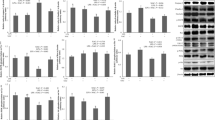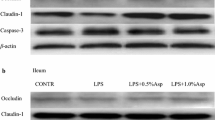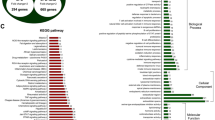Abstract
This study determined whether N-acetylcysteine (NAC) could affect intestinal redox status, proinflammatory cytokines, epidermal growth factor (EGF), EGF receptor (EGFR), Toll-like receptor-4 (TLR4), and aquaporin-8 in a lipopolysaccharide (LPS)-challenged piglet model. Eighteen piglets (35-day-old) were randomly allocated into one of the three treatments (control, LPS and NAC). The control and LPS groups were fed a basal diet, and the NAC group received the basal diet +500 mg/kg NAC. On days 10, 13, and 20 of the trial, the LPS- and NAC-treated piglets received intraperitoneal administration of LPS (100 μg/kg BW), whereas the control group received the same volume of saline. On days 10 and 20, venous blood samples were obtained at 3 h post LPS or saline injection. On day 21 of the trial, piglets were killed to obtain the intestinal mucosa for analysis. Compared with the control group, LPS challenge reduced (P < 0.05) the activities of superoxide dismutase, catalase, and glutathione peroxidase in jejunal mucosae, while increasing (P < 0.05) the concentrations of malondialdehyde, H2O2, O2 ·− and the ratio of oxidized to reduced glutathione in jejunal mucosae, and concentrations of TNF-α, cortisol, interleukin-6, and prostaglandin E2 in both plasma and intestinal mucosae. These adverse effects of LPS were attenuated (P < 0.05) by NAC supplementation. Moreover, NAC prevented LPS-induced increases in abundances of intestinal HSP70 and NF-κB p65 proteins and TLR4 mRNA. NAC supplementation enhanced plasma EGF concentration and intestinal EGFR mRNA levels. Collectively, these results indicate that dietary NAC supplementation alleviates LPS-induced intestinal inflammation via regulating redox, EGF, and TLR4 signaling.


Similar content being viewed by others
Abbreviations
- AQP:
-
Aquaporin
- EGF:
-
Epidermal growth factor
- GAPDH:
-
Glyceraldehyde 3-phosphate dehydrogenase
- HSP70:
-
Heat shock protein 70
- LPS:
-
Lipopolysaccharide
- NF-κB:
-
Nuclear factor κB
- RT-PCR:
-
Real-time polymerase-chain reaction
- TLR4:
-
Toll-like receptor 4
- TNF-α:
-
Tumor necrosis factor-alpha
References
Beere HM, Wolf BB, Cain K et al (2000) Heat-shock protein 70 inhibits apoptosis by preventing recruitment of procaspase-9 to the Apaf-1 apoptosome. Nat Cell Biol 2:469–475
Bergen WG, Wu G (2009) Intestinal nitrogen recycling and utilization in health and disease. J Nutr 139:821–825
Blackwell TS, Blackwell TR, Holden EP et al (1996) In vivo antioxidant treatment suppresses nuclear factor-kappa B activation and neutrophilic lung inflammation. J Immunol 157:1630–1637
Brosnan JT, Brosnan ME (2012) Glutamate: a truly functional amino acid. Amino Acids. doi:10.1007/s00726-012-1280-4
Dai ZL, Wu G, Zhu WY (2011) Amino acid metabolism in intestinal bacteria: links between gut ecology and host health. Front Biosci 16:1768–1786
Dai ZL, Li XL, Xi PB (2012) l-Glutamine regulates amino acid utilization by intestinal bacteria. Amino Acids. doi:10.1007/s00726-012-1264-4
Deng D, Yin YL, Chu WY et al (2009) Impaired translation initiation activation and reduced protein synthesis in weaned piglets fed a low-protein diet. J Nutr Biochem 20:544–552
Engler JA, Gupta A, Li L et al (1999) Inhibition of DNA synthesis in Caco-2 cells by oxidative stress amelioration by epidermal growth factor. Dig Dis Sci 44:1902–1909
Fang YZ, Yang S, Wu G (2002) Free radicals, antioxidants, and nutrition. Nutrition 18:872–879
Fishbane S, Durham JH, Marzo K et al (2004) N-Acetylcysteine in the prevention of radiocontrast-induced nephropathy. J Am Soc Nephrol 15:251–260
Fu WJ, Stromberg AJ, Viele K et al (2010) Statistics and bioinformatics in nutritional sciences: analysis of complex data in the era of systems biology. J Nutr Biochem 21:561–572
Gao KG, Jiang ZY, Lin YC et al (2011) Dietary l-arginine supplementation enhances placental growth and reproductive performance in sows. Amino Acids. doi:10.1007/s00726-011-0960-9
Geng MM, Li TJ, Kong XF et al (2011) Reduced expression of intestinal N-acetylglutamate synthase in suckling piglets: a novel molecular mechanism for arginine as a nutritionally essential amino acid for neonates. Amino Acids 40:1513–1522
Gribar SC, Anand RJ, Sodhi CP et al (2008) The role of epithelial Toll-like receptor signaling in the pathogenesis of intestinal inflammation. J Leukoc Biol 83:493–498
Hardin JA, Wallace LE, Wong JF et al (2004) Aquaporin expression is downregulated in a murine model of colitis and in patients with ulcerative colitis, Crohnʼs disease and infectious colitis. Cell Tissue Res 318:313–323
Helmrath MA, Shin CE, Erwin CR (1998) Intestinal adaptation is enhanced by epidermal growth factor independent of increased ileal epidermal growth factor receptor expression. J Pediatr Surg 33:980–985
Hou YQ, Wang L, Ding BY et al (2010) Dietary α-ketoglutarate supplementation ameliorates intestinal injury in lipopolysaccharide-challenged piglets. Amino Acids 39:555–564
Hou YQ, Yao K, Wang L et al (2011a) Effects of a-ketoglutarate on energy status in the intestinal mucosa of weaned piglets chronically challenged with lipopolysaccharide. Br J Nutr 106:357–363
Hou YQ, Wang L, Ding BY et al (2011b) Alpha-ketoglutarate and intestinal function. Front Biosci 16:1186–1196
Hou YQ, Wang L, Zhang W et al (2011c) Protective effects of N-acetylcysteine on intestinal functions of piglets challenged with lipopolysaccharide. Amino Acids. doi:10.1007/s00726-011-1191-9
Kawai T, Akira S (2006) TLR signaling. Cell Death Differ 13:816–825
Knight KR, MacPhadyen K, Lepore DA et al (1991) Enhancement of ischaemic rabbit skin flap survival with the antioxidant and free-radical scavenger N-acetylcysteine. Clin Sci (Lond) 81:31–36
Kregel KC (2002) Heat shock proteins: modifying factors in physiological stress responses and acquired thermotolerance. J Appl Physiol 92:2177–2186
Leaphart CL, Cavallo J, Gribar SC et al (2007) A critical role for TLR4 in the pathogenesis of necrotizing enterocolitis by modulating intestinal injury and repair. J Immunol 179:4808–4820
Lehmann GL, Carreras FI, Soria LR et al (2008) LPS induces the TNF-alpha-mediated downregulation of rat liver aquaporin-8: role in sepsis-associated cholestasis. Am J Physiol Gastrointest Liver Physiol 294:G567–G575
Li P, Yin YL, Li DF et al (2007) Amino acids and immune function. Br J Nutr 98:237–252
Li P, Kim SW, Li XL et al (2009) Dietary supplementation with cholesterol and docosahexaenoic acid affects concentrations of amino acids in tissues of young pigs. Amino Acids 37:709–716
Li FN, Yin YL, Tan BE et al (2011a) Leucine nutrition in animals and humans: mTOR signaling and beyond. Amino Acids 41:1185–1193
Li XL, Rezaei R, Li P et al (2011b) Composition of amino acids in feed ingredients for animal diets. Amino Acids 40:1159–1168
Liu Y, Huang J, Hou Y et al (2008) Dietary arginine supplementation alleviates intestinal mucosal disruption induced by Escherichia coli lipopolysaccharide in weaned pigs. Br J Nutr 100:552–560
Lobo SM, De Backer D, Sun Q et al (2003) Gut mucosal damage during endotoxic shock is due to mechanisms other than gut ischemia. J Appl Physiol 95:2047–2054
Matsuzaki T, Tajika Y, Ablimit A et al (2004) Aquaporins in the digestive system. Med Electron Microsc 37:71–80
Mercer DW, Smith GS, Cross JM et al (1996) Effects of lipopolysaccharide on intestinal injury: potential role of nitric oxide and lipid peroxidation. J Surg Res 63:185–192
Nair RR, Warner BB, Warner BW (2008) Role of epidermal growth factor and other growth factors in the prevention of necrotizing enterocolitis. Semin Perinatol 32:107–113
Ren WK, Luo W, Wu MM et al (2011a) Dietary l-glutamine supplementation improves pregnancy outcome in mice infected with type-2 porcine circovirus. Amino Acids. doi:10.1007/s00726-011-1134-5
Ren W, Yin YL, Liu G et al (2011b) Effect of dietary arginine supplementation on reproductive performance of mice with porcine circovirus type 2 infection. Amino Acids. doi:10.1007/s00726-011-0942-y
Rezaei R, Knabe DA, Li XL et al (2011) Enhanced efficiency of milk utilization for growth in surviving low-birth-weight piglets. J Anim Sci Biotech 2:73–83
Rhoads JM, Wu G (2009) Glutamine, arginine, and leucine signaling in the intestine. Amino Acids 37:111–122
Ryan CK, Miller JH, Seydel AS et al (1997) Epidermal growth factor and neurotensin induce microvillus hypertrophy following massive enterectomy. J Gastrointest Surg 1:467–473
Satterfield MC, Dunlap KA, Keisler DH et al (2011) Arginine nutrition and fetal brown adipose tissue development in nutrient-restricted sheep. Amino Acids. doi:10.1007/s00726-011-1168-8
Satterfield MC, Dunlap KA, Keisler DH et al (2012) Arginine nutrition and fetal brown adipose tissue development in diet-induced obese sheep. Amino Acids. doi:10.1007/s00726-012-1235-9
Takata K, Matsuzaki T, Tajika Y (2004) Aquaporins: water channel proteins of the cell membrane. Prog Histochem Cytochem 39:1–83
Tan BE, Yin YL, Liu ZQ et al (2009a) Dietary l-arginine supplementation increases muscle gain and reduces body fat mass in growing-finishing pigs. Amino Acids 37:169–175
Tan BE, Li XG, Kong XF et al (2009b) Dietary l-arginine supplementation enhances the immune status in early-weaned piglets. Amino Acids 37:323–331
Tan BE, Yin YL, Kong XF et al (2010) l-arginine stimulates proliferation and prevents endotoxin-induced death of intestinal cells. Amino Acids 38:1227–1235
Thomson ABR, Keelan M, Thiesen A et al (2001) Small bowel review diseases of the small intestine. Dig Dis Sci 46:2555–2566
Wang JJ, Chen LX, Li DF et al (2008) Intrauterine growth restriction affects the proteomes of the small intestine, liver and skeletal muscle in newborn pigs. J Nutr 138:60–66
Wang XQ, Ou DY, Yin JD et al (2009) Proteomic analysis reveals altered expression of proteins related to glutathione metabolism and apoptosis in the small intestine of zinc oxide-supplemented piglets. Amino Acids 37:209–218
Wang JJ, Wu ZL, Li DF et al (2012) Nutrition, epigenetics, and metabolic syndrome. Antioxid Redox Signal. doi:10.1089/ars.2011.4381
Webel DM, Finck BN, Baker DH et al (1997) Time course of increased plasma cytokines, cortisol and urea nitrogen in pigs following intraperitoneal injection of lipopolysaccharide. J Anim Sci 75:1514–1520
Wei JW, Carroll RJ, Harden KK et al (2012) Comparisons of treatment means when factors do not interact in two-factorial studies. Amino Acids 42:2031–2035
Wilson FA, Suryawan A, Orellana RA et al (2011) Differential effects of long-term leucine infusion on tissue protein synthesis in neonatal pigs. Amino Acids 40:157–165
Wu G (2009) Amino acids: metabolism, functions, and nutrition. Amino Acids 37:1–17
Wu G (2010a) Functional amino acids in growth, reproduction, and health. Adv Nutr 1:31–37
Wu G (2010b) Recent advances in swine amino acid nutrition. J Anim Sci Biotechnol 1:49–61
Wu G, Fang YZ, Yang S et al (2004) Glutathione metabolism and its implications for health. J Nutr 134:489–492
Wu G, Bazer FW, Burghardt RC et al (2011a) Proline and hydroxyproline metabolism: implications for animal and human nutrition. Amino Acids 40:1053–1063
Wu G, Bazer FW, Johnson GA et al (2011b) Important roles for l-glutamine in swine nutrition and production. J Anim Sci 89:2017–2030
Xi PB, Jiang ZY, Zheng CT et al (2011) Regulation of protein metabolism by glutamine: implications for nutrition and health. Front Biosci 16:578–597
Yamamoto T, Kuramoto H, Kadowaki M (2007) Downregulation in aquaporin 4 and aquaporin 8 expression of the colon associated with the induction of allergic diarrhea in a mouse model of food allergy. Life Sci 81:115–120
Yao C, Purwanti N, Karabasil MR et al (2010) Potential down-regulation of salivary gland AQP5 by LPS via cross-coupling of NF-kappaB and p-c-Jun/c-Fos. Am J Pathol 177:724–734
Yao K, Yin YL, Li XL et al (2011) Alpha-ketoglutarate inhibits glutamine degradation and enhances protein synthesis in intestinal porcine epithelial cells. Amino Acids. doi:10.1007/s00726-011-1060-6
Yu BP (1994) Cellular defenses against damage from reactive oxygen species. Physiol Rev 74:139–162
Zafarullah M, Li WQ, Sylvester J et al (2003) Molecular mechanisms of N-acetylcysteine actions. Cell Mol Life Sci 60:6–20
Acknowledgments
This research was jointly supported by National Natural Science Foundation of China (Grant No. 30871801), National Natural Science Foundation of China (No. 30972213), Wuhan Disciplines Leaders Project (Grant No. 200951830554), the Program for Innovative Research Groups of Hubei Provincial Natural Science Foundation (Grant No. 2007ABC009), the Thousand-People Talent program at China Agricultural University, Chinese Universities Scientific Fund (2012RC024), and National Research Initiative Competitive Grants from the Animal Growth and Nutrient Utilization Program (2008-35206-18764) of the USDA National Institute of Food and Agriculture, and Texas AgriLife Research (H-82000).
Conflict of interest
The authors declare that they have no conflict of interest.
Author information
Authors and Affiliations
Corresponding authors
Rights and permissions
About this article
Cite this article
Hou, Y., Wang, L., Yi, D. et al. N-acetylcysteine reduces inflammation in the small intestine by regulating redox, EGF and TLR4 signaling. Amino Acids 45, 513–522 (2013). https://doi.org/10.1007/s00726-012-1295-x
Received:
Accepted:
Published:
Issue Date:
DOI: https://doi.org/10.1007/s00726-012-1295-x




